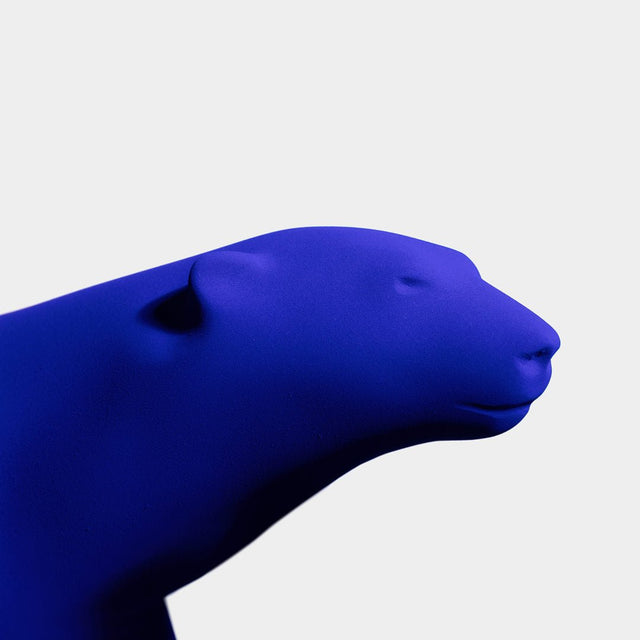About Yves Klein:
Yves Klein was born on April 28, 1928 in the south of France and grew up near Nice. The son of Fred Klein and Marie Raymond, both painters, Yves Klein was a self-taught artist.
Klein's work is marked by three "milestones". His Monotone-Silence Symphony, his ultramarine blue monochrome paintings and his Leap into the Void. Growing up in a household whose parents were painters and hosted recurring artistic discussions with the attendance of other painters, made Klein want to overcome the barriers of conventional art and painting.
His desire to capture the void had certain avant-garde elements that were undoubtedly intended to lend the occasion an absurd touch. However, these aspects concealed a deeply serious reasoning. Klein spent most of his career searching for an aesthetic expression of “the emptiness". He delved into the concept of “the totality of things”, which by being so vast becomes empty, a quality similar to that of the sky or the ocean.
Based on this idea, Yves Klein freed color from the cage that the stroke represented through his monochrome canvases, which were initially of various colors, but were eventually simplified even further to the point that he would only produce them in what would become the famous IKB (International Klein Blue).
In 1962 he died suddenly, leaving behind an artistic legacy that would go down in the history of contemporary art.
To learn more about the work of Yves Klein, you can read this post.
About Françcois Pompon:
François Pompon was born on 9 May 1855, in Saulieu, in the French Burgundy. His father, a cabinetmaker, taught him his trade and found him his first job with a local marble worker, who taught him to carve stone before beginning his studies at the École des Beaux-Arts in Dijon. There he studied architecture and sculpture with François Dameron and the rudiments of engraving with Célestin Nanteuil.
In 1874, after being awarded a local prize, François Pompon moved to Paris where he kept learning and living by his trade. He settled in Rue Campagne-Premiére, in the Montparnasse district. During this period François Pompon established relationships with the promoters that were transforming Paris by the time of Napoleon III. This got him to perfect his technique by making decorative figures for the façades and caryatids of the Hôtel de Ville, which was burnt down during the Paris Commune. Meanwhile, in the afternoon he attended the Ecole Nationale des Arts Décoratifs, where he studied with Aimé Millet and Caillé and where Pompon met Pierre-Louis Rouillard, a sculptor of animal figures who was to become a great source of inspiration.
In 1882 he married Berthe Valain, who, like her mother, worked as a dressmaker. At this time he tried to be independent and to create his own work. Although his first large sculpture Cosette catch the eye of the jury of the Salon, a successful career as a sculptor still seemed to be far.
From 1896 Pompon began to collaborate a lot with Renée de Saint-Marceaux, a famous sculptor of the time. Pompon did this until Marceaux's death in 1915. With the pressure of his commercial activity, he rarely had enough time to sculpt the human face, although he left a few figures, including a portrait of his wife. During this period, François Pompon kept searching for his own style and the preference for sculpting in the open air played an important role. For this purpose he developed an ingenious mobile sculpture unit. His Grand Cerf (Large Deer) and Pelican sculptures date from this period.
His talent was discovered by Antonin Mercié, author of the Gloria Victis, whose assistant Pompon became before working for Alexandre Falguière and finally for Auguste Rodin. Three years after working with Rodin, he became head of the workshop, a post he held for the next 15 years.
His membership of the Bande à Schnegg, a group of sculptors linked to Rodin's workshop, also had a great influence. Collectively, they sought new stylized forms based on the monumental serenity of classical sculpture. In Pompon's work, form takes a second place after the light, which Pompon emphasized through a smooth finish of the surface. Unable to capture the whiteness that had so impressed him in a goose, Pompon played with the bird's reliefs, making them lose their depth and achieving a balance between color and shadows dictated by the light. "I like sculpture without hollows or shadows”.
During his time with Rodin, Pompon began to focus more and more on animal figures, although his work remained unappreciated and he went through a bad patch. It was not until 1919 that his work began to attract more interest. His recognition came at the age of 67 with his Ours Blanche (Polar Bear), which was exhibited at the Salon d'Automne in 1922. Le Taureau (The Bull), commissioned by the city of Paris, was his last work.
In his will, François Pompon donated his 300 works to the French state, which were first kept in the Pompon Museum at the Botanical Garden in Paris and then transferred to the Palais des Ducs de Bourgogne, where the Musée des Beaux-Arts in Dijon is located.
